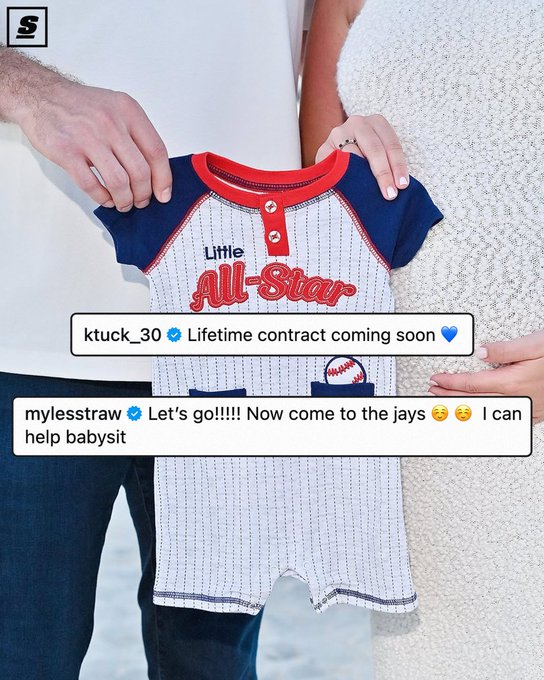Kyle Tucker and his wife announced on IG they were expecting a baby... and Blue Jays outfielder Myles Straw had to go into recruiting mode. 😂😂😂
Why the Blue Jays should pursue Kyle Tucker even if it means Bo Bichette walks

Photo credit: © Kamil Krzaczynski-Imagn Images
Nov 23, 2025, 09:00 ESTUpdated: Nov 23, 2025, 08:39 EST
The Blue Jays have some big decisions to make this offseason that could directly impact their likelihood of repeating as AL East champions next season. The team seems perfectly willing to spend to improve the team, which should give them an advantage for some of the bigger names available. The Blue Jays are currently seen as ‘front-runners’ for perhaps the biggest free agent on the market, outfielder Kyle Tucker.
Meanwhile, homegrown star Bo Bichette has also hit free agency this winter and should also be a priority for the Jays. Bringing both back would be great, but assuming that they have to choose one way or another, let’s take a look at who would be more impactful in Toronto going forward.
Offensive consistency
Tucker and Bichette have both been full-time starters for five seasons, with one of those years resulting in a half-season due to injuries. This makes it easy to compare their career numbers.
When looking at Tucker’s production, it’s impressive how consistent he’s been since becoming a full-time starter in 2021. In those five years ending with the 2025 season, here are the fWARs that he’s produced: 4.9, 4.9, 4.9, 4.2, 4.5.
That 4.2 season in 2024 is particularly impressive given the fact that he played in just 78 games. A high walk rate mixed with a low strikeout rate and consistent power numbers has made the former Astro and Cub one of the most reliable offensive forces in the game. He also contributes on the base paths, swiping at least 25 bases in each of the last three full seasons that he’s played. His instincts go a long way towards those stolen base numbers, as his sprint speed is surprisingly in just the 26th percentile, per Baseball Savant.
Bichette’s career years are on par with Tucker’s, at least as far as fWAR goes.
His 4.9 WAR in 2021 matches Tucker’s career high, while he also posted a 4.8 mark in 2022. His other two full seasons (2023, 2025) were a bit less impactful (3.9, 3.8), but the 2024 season output (0.3) is perhaps the biggest cause for concern. Unlike Tucker, Bichette produces his value based on his high-contact approach. His aggressiveness means that he walks significantly less often, leaving less margin for error if he isn’t hitting his way on base. The 2024 season may have shown us a glimpse of what may happen when his contact skills take a hit, leaving him with a .277 OBP and marginal power. You can certainly make a case that injuries derailed that season and led to the weaker numbers, but that’s becoming a trend in its own right. Bichette has made six different trips to the injured list over the last two seasons.
Defense
Tucker grades out as a league-average right fielder who is limited by his sprint speed but provides value with his throwing arm. His range fell in the 26th percentile, a mark that will probably only get worse as he ages. However, his arm value was in the 83rd percentile, showing he can be a threat to throw out runners when given the chance.
By simply being an average middle infielder, Bichette would easily clear Tucker in terms of defensive value. Over his first four years starting, he amassed a cumulative Fangraphs defensive value of 8.9, compared to the -11.9 mark that Tucker produces in the outfield. However, the wheels fell off in 2025, leading to Bichette grading out as the worst defensive shortstop in baseball and amassing a -6.0 value, compared to -5.1 for Tucker.
A move to second base for Bichette seems almost inevitable, but that may not mean that he will be a plus or even average player there either. Although his throwing arm is also not a strength, his biggest issue was his range (1st percentile), something that will likely continue to plague him at second base. Without the defensive value, it puts that much more emphasis on his offensive game and leaves less margin for error as far as providing value in his 30s.
Taking emotion out of the equation
It’s always hard to move on from players that are drafted and developed and quickly become fan favourites. Mix in a heroic playoff appearance in which he played hurt and still managed to hit a massive three-run home run in game seven of the World Series, and it makes things really tough to move on. His World Series moments were spectacular, but it’s important that the team doesn’t let that affect this long-term decision.
Bo Bichette just unleashed one of the coldest bat flips ever 🥶
There’s a reason why Tucker is expected a sign a contract worth around 10 years and $400 million. His consistency and patient approach make it very likely that he maintains similar production into his 30s, making him a high-floor, high-ceiling signing that a team can rely on for years to come.
When you take emotion out of the equation, there are certainly some red flags with Bichette’s future that should give teams pause with giving him a long-term contract. That is true regardless of whether the team brings Tucker in or not. The defensive uncertainty and reliance on contact skills could result in him being a much less valuable player once age starts its decline toward the back part of the deal, especially if Bichette stays on the left side of the infield moving forward.
Final verdict
If the Blue Jays can get a deal done in the 3-5 year range (perhaps with opt-outs), then it could be feasible to net both players.
Chances are, there will be a team that is interested in a 6-8 year deal with the former shortstop, which probably means that the Blue Jays have to make a decision which basket to put their eggs into. Although he will cost more money in both AAV and in total years, Tucker would be the better decision that would have a much bigger impact on the future of the Blue Jays.

Presented by Betway

